We’ve all experienced that moment—discovering something so good you can’t wait to tell everyone you know. “This coffee shop changed my life.” “You’ve got to try this app.” “This product saved me hours every week.”
That enthusiastic word-of-mouth is marketing gold. But left to chance, it remains a happy accident rather than a growth engine.
Smart brands capitalize on this natural human behavior by turning customer excitement into structured referral programs. But here’s where many companies stumble: they build the program, launch it with fanfare… and then watch engagement flatline because customers either forget it exists or find it too cumbersome to use.
The difference between a referral program that gathers dust and one that drives significant revenue? Strategic promotion and seamless customer experience. In this guide, we’ll examine how five innovative brands have mastered this challenge, creating referral programs that customers actively want to participate in.
Why promoting your program far and wide is important
Even the most cleverly designed referral program is worthless if it remains your best-kept secret. Many brands invest heavily in structuring enticing rewards, only to bury the program three clicks deep on their website where it withers from neglect.
The harsh reality? Your customers aren’t hunting for ways to promote your brand. The enthusiasm gap between “loving your product” and “actively referring others” is wider than most marketers realize.
Doug Lewis, Growth and Marketing Officer at Trusted Health, crystalizes this challenge perfectly:
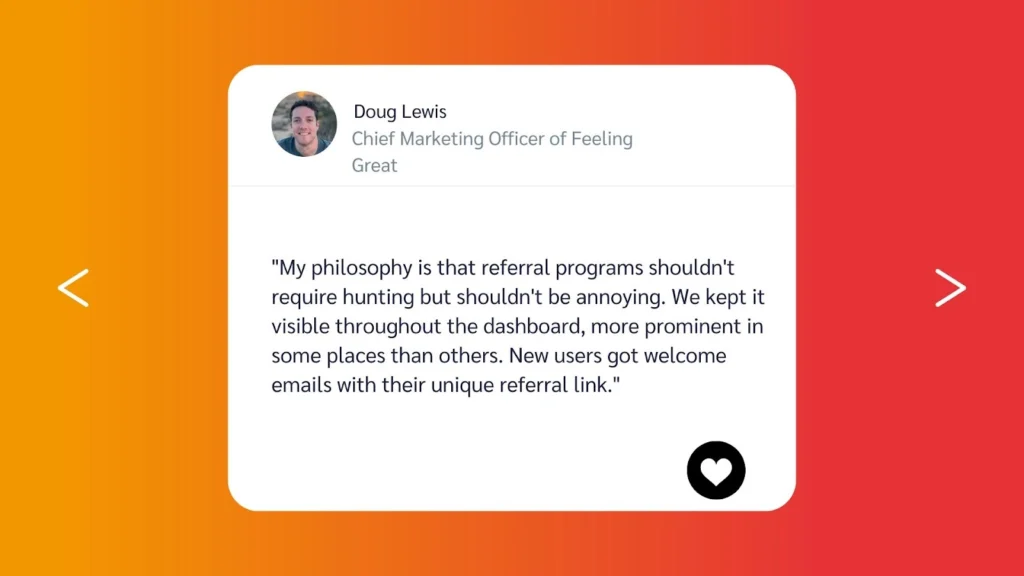
Successful referral promotion requires understanding the psychology of sharing. Customers typically refer others during moments of peak satisfaction—after a successful purchase, when receiving exceptional customer service, or when they’ve just discovered a feature that solves a persistent problem.
These “advocacy triggers” are your prime opportunities to showcase your referral program through strategic placement:
- Post-purchase touchpoints when satisfaction is highest
- Customer account dashboards where engaged users regularly interact
- Mobile app notifications delivered at moments of successful interaction
- Community forums where your superfans already congregate
- Social proof moments when customers are publicly praising your product
5 examples of brands with referral marketing and loyalty promotion ideas that stole the show
Behind every viral referral campaign lies calculated strategy, not lucky breaks. The difference-makers? Programs that combine creativity, simplicity, and genuine value for both parties in the referral equation.
While most companies settle for “refer-a-friend” afterthoughts, these five brands have elevated referral marketing to an art form—engineering word-of-mouth at scale through strategic program design and promotion. Their approaches vary widely, but each delivers a masterclass in turning satisfied customers into tireless brand advocates.
Referral marketing idea 1: Staples uses a colorful explainer page to entice customers
Staples uses a clear explainer page for their loyalty program. It breaks down how customers can earn points every time they shop—and how they can redeem points for future purchases. The system’s simplicity makes it easy for customers to understand and engage with, which helps build a stronger connection with the brand.
Why we love it
- Bright, on-brand colors: The explainer page is visually appealing, using Staples’ signature red and white color scheme along with a new color (purple) to grab attention and maintain brand consistency.
- Easy-to-follow visuals: Clear graphics and step-by-step instructions make it easy for customers to understand how to sign up and start earning points.
- Detailed FAQ section: A thorough FAQ section reduces friction by answering common questions upfront, reducing support tickets, and improving the overall customer experience.
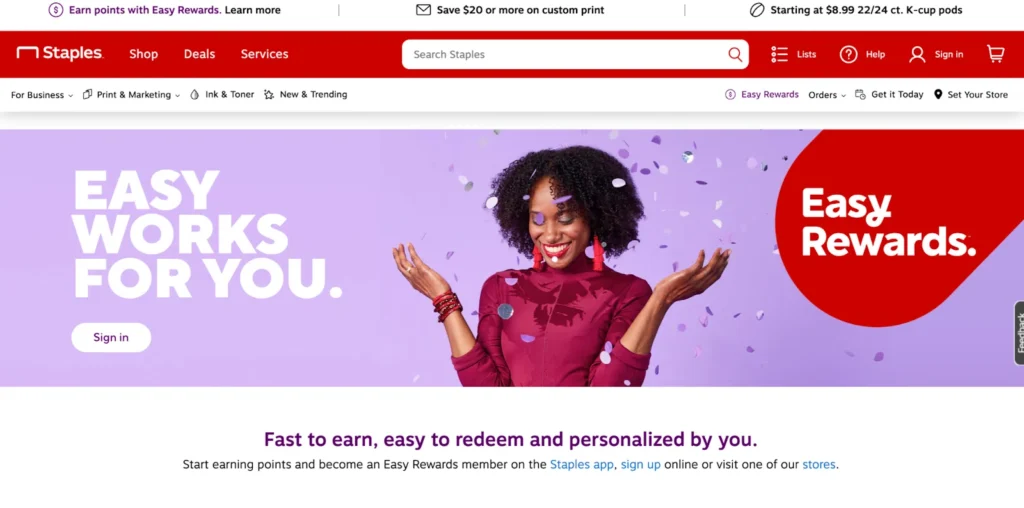
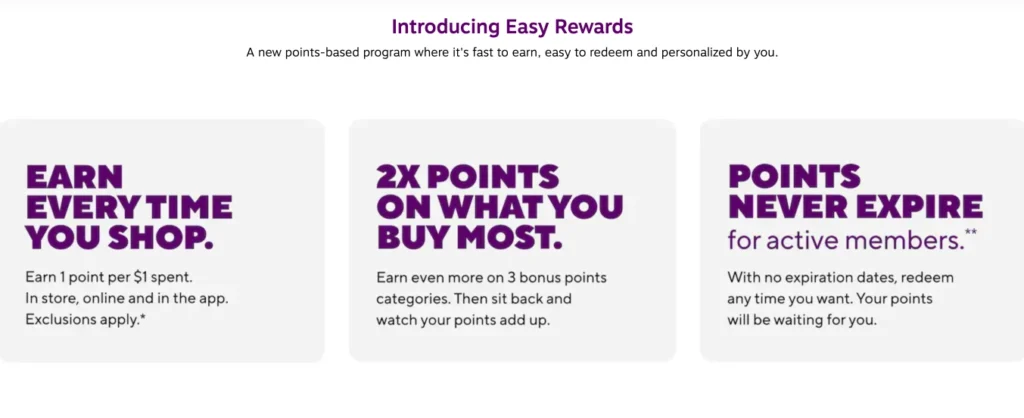
Only 44 percent of consumers participate in referral programs, and just 43 percent have ever received a referral code or link, highlighting huge growth potential. A well-designed explainer page like Staples’ helps close that gap by educating customers on how a referral or loyalty program works and its value.
Customers are more likely to engage when they understand the benefits and see how easy it is to participate.
Referral marketing idea 2: Bowlero partners with creators to reach niche audiences
Bowling company Bowlero partners with influencers to spread the word about their bowling alleys. In one example, lifestyle influencer Ailynn shared a post on Instagram offering her followers 15 percent off Bowlero on St. Patrick’s Day when they use her unique referral code.
The post feels genuine and approachable. Ailynn is simply sharing a fun night out with her family, which makes the promotion feel less like an ad and more like a personal recommendation.
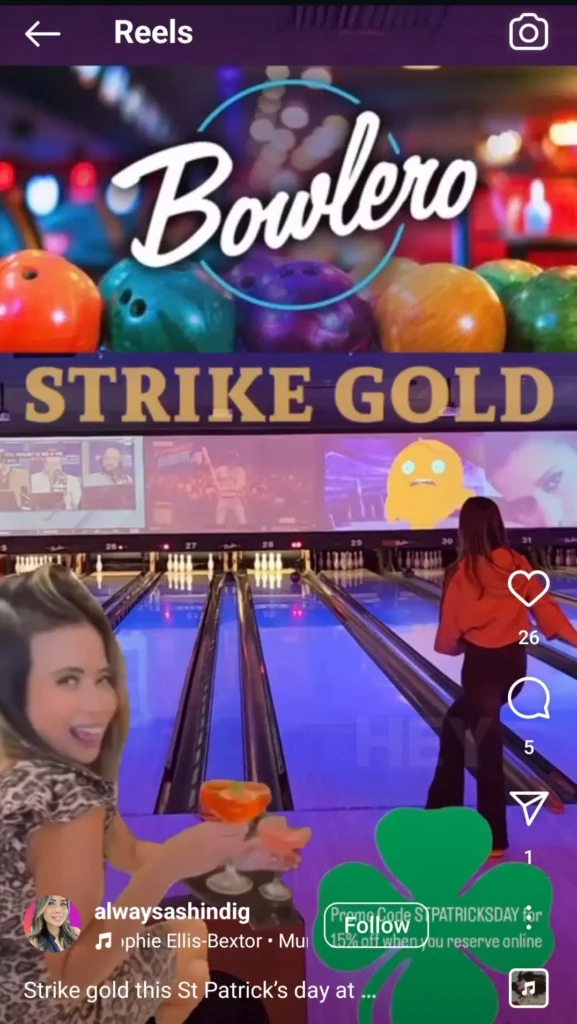
Ailynn shares a fun night out with her family at Bowlero.
Why we love it
Reach through a nano-influencer. Even though Ailynn has under 6K followers, her audience is highly engaged, particularly families looking for an easy, affordable night out.
Authenticity. The post is a relatable, everyday moment of Ailynn spending time with her family. That authenticity builds trust and makes the referral feel natural rather than forced.
This referral marketing strategy works well because not all customers who love your product are ready to join a formal partnership. But they might still be willing to share your brand with their followers for a reward.
Working with micro and nano-influencers allows brands to tap into smaller, more engaged audiences. You can motivate them to share user-generated content (UGC) by offering VIP rewards, early product access, or special discounts.
UGC refers to content created by customers or influencers that features your brand. These creators provide value by offering authentic, relatable content that resonates with their audience. Brands benefit from UGC because it feels more genuine than traditional ads and helps establish trust with potential customers.
Referral marketing idea 3: Blink Health has a prominent website placement for increased visibility
Blink Health makes it easy for users to find and engage with their referral program by placing the program directly in the app’s main menu. Customers naturally encounter the program during regular app usage, which increases participation without requiring extra effort.
Strategic placement reduces friction and makes it easy for customers to engage with the program. When the referral option is front and center, it increases the chances that customers will use it.
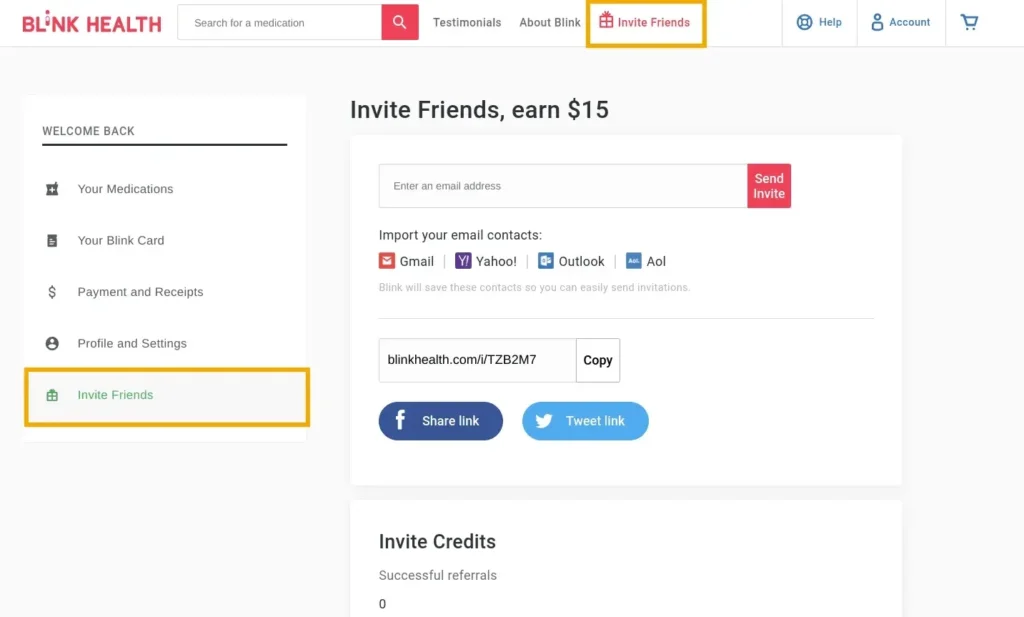
Why we love it
- Visible placement: The referral program is easy to spot in the customer login menu, meaning customers don’t have to search for it.
- Multiple referral options: Blink Health lets customers share their referral links via social media or email, giving them flexibility in promoting the program.
Proper placement is key to driving participation. Referral programs need to be easy to find and frictionless to use. Customers who have to dig through menus or settings to find a referral link are less likely to engage.
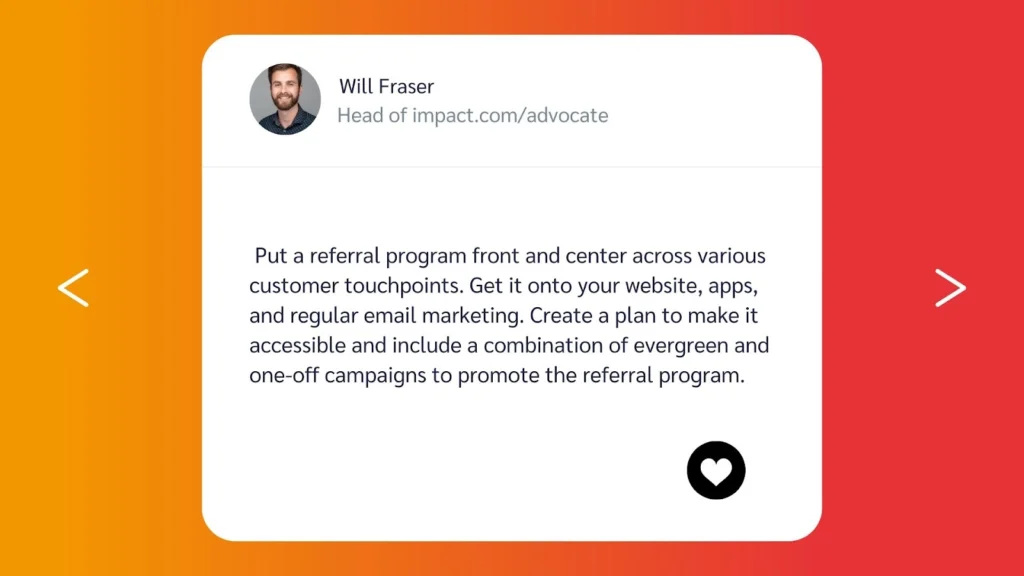
Referral marketing idea 4: Instacart uses in-app messages to encourage sharing
Instacart lets customers share referral links directly within the app. The app prominently features the offer with a bright “Give $10 Get $10 link at the top of the main menu, ensuring that it’s one of the first things users see when they open the app.
A smart addition is the app showing how much the customer has earned so far. The consistent nudge encourages users to share the program and maximize their rewards.
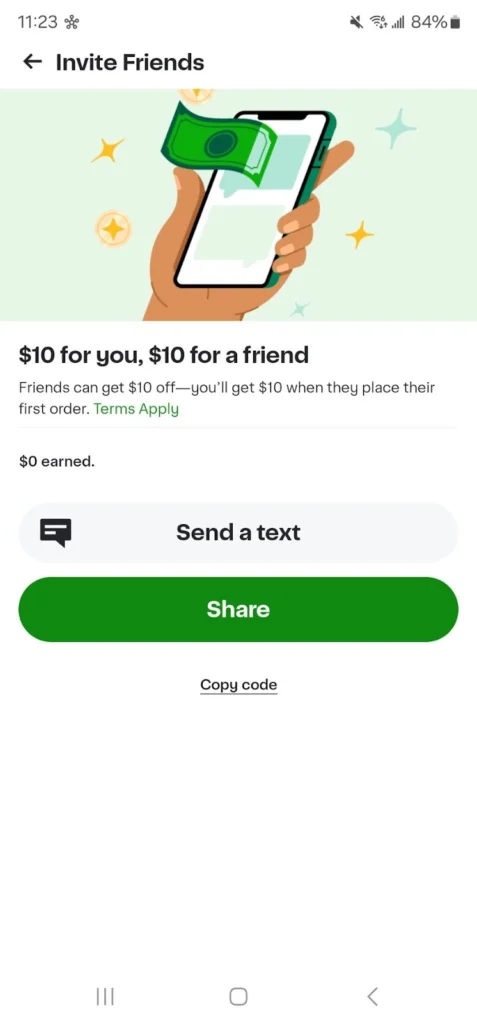
Additionally, the brand has an “Invite a business program” where the referrer gets $40 discount while the new business gets free delivery for a year. The program has a unique sharing function: customers can share the program via a QR code.
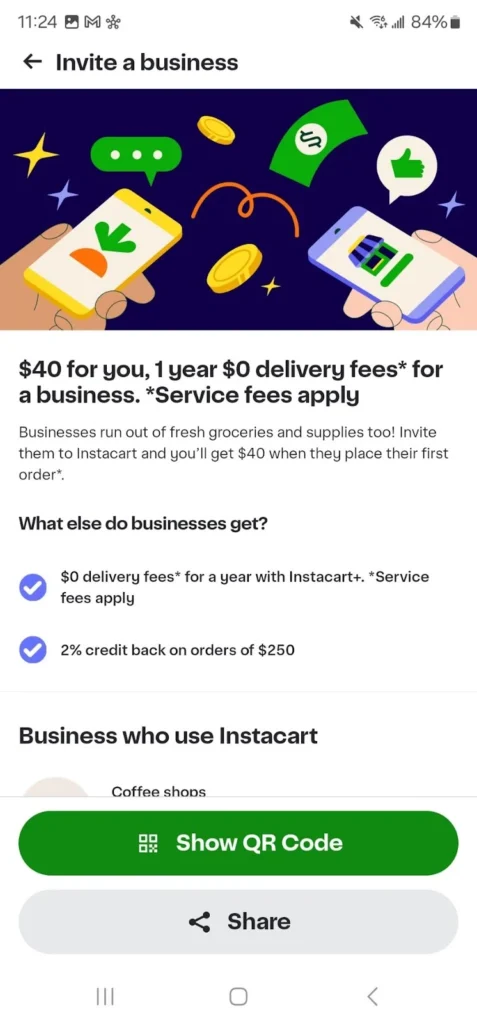
Why we love it
High visibility. Placing the referral program at the top of the main menu makes it hard to miss, increasing the chances that customers will engage with it. Meeting customers where they are in the app streamlines the referral process.
Consistent reminders. The status bar showing current rewards keeps the program at the top of users’ minds. Plus there are multiple sharing options, such as sharing via message or QR code. All these opportunities motivate referrers to participate so they don’t miss out on potential rewards.
Double-sided incentive. A double-sided program like Instacart’s can be more effective because it incentivizes the referrer and the new customer. 65 percent of referrers say they prefer it when rewards are shared––people feel more inclined to refer a brand when a friend also benefits. This structure tends to drive higher engagement because both parties feel valued.
Referral marketing idea 5: Postable used a minimal text email to get eyes on its program
Postable keeps things simple with its referral program. Customers get $5 credit for each friend they refer, and their friend gets $5 when they sign up and spend at least $20.
The email promoting the program is short and to the point, with a clear call to action encouraging customers to share their personal promo code. The more friends that join, the more credit the referrer earns.
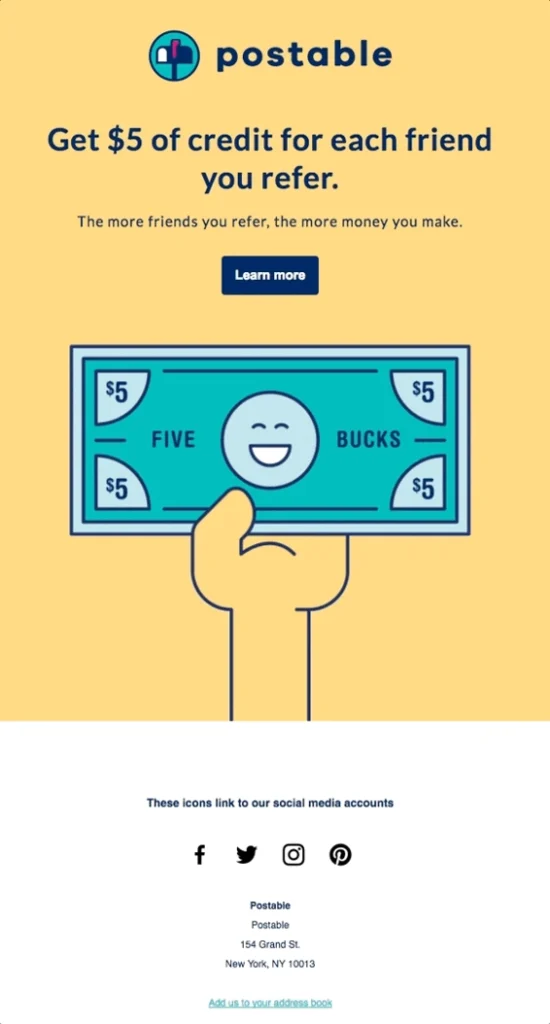
Why we love it
- Minimal copy: The email is clean and straightforward, making it easy for customers to understand the offer at a glance.
- Playful visuals: Fun, colorful cartoon imagery adds personality and keeps the email from feeling too sales-like.
Email is one of the most effective ways to promote a referral program, but it shouldn’t be a one-off campaign.
To maximize engagement, brands should embed referral program messaging into different types of emails:
- Post-purchase emails: Thank customers for their order and suggest sharing their referral link or code as a way to save on their next purchase.
- Referral launch emails: Announce the program and explain the benefits clearly.
- Onboarding emails: Include the referral program as part of the customer’s welcome journey so they’re aware of it from day one.
- Email signatures: Adding the referral program link to customer service or transactional email signatures gives it extra visibility.
Embedding referral program messaging into multiple email touchpoints will increase visibility and engagement. A single email blast probably won’t cut it. Instead, repetition across different customer interactions ensures that more people see and act on the offer.
Test, test, and test for success
Setting up a referral program is the beginning. To maximize long-term success, you must continuously test and refine your approach. A/B testing helps you figure out what works and what doesn’t.
Create your referral testing framework
Successful A/B testing for referral programs requires methodical planning:
- Establish clear baselines before any test begins. Document your current conversion rate, participation rate, and average referral value to measure improvements against.
- Test one element at a time to isolate what’s actually moving the needle. When you change multiple variables simultaneously, you can’t determine which one drove the improvement.
- Ensure statistical significance by running tests until you’ve reached an adequate sample size. For most referral programs, this means continuing each test until at least 100-200 conversions per variation.
High-impact referral program elements worth testing
Focus your testing efforts on these referral program elements with outsized impact:
Message framing: Test benefit-focused messaging (“Get $10 off”) against altruistic framing (“Give your friends $10”). Research shows that certain customer segments respond dramatically differently to these approaches.
Incentive structures:
- Fixed rewards vs. percentage discounts
- Immediate rewards vs. milestone-based bonuses
- Equal rewards vs. referrer-weighted or referee-weighted incentives
Placement optimization:
- Test prominent dashboard placement against subtle navigation mentions
- Compare post-purchase screen prominence against account settings placement
- Evaluate modal pop-ups (after significant engagement) against passive sidebar placement
Visual presentation:
- Minimalist design vs. attention-grabbing graphics
- Text-based CTA vs. button-based interface
- Process visualization (showing steps) vs. outcome focus (showing rewards)
Measurement beyond clicks
The most sophisticated referral programs track metrics beyond surface-level engagement:
- Referral quality: Are referred customers higher or lower lifetime value than other acquisition channels?
- Time-to-refer: How long after joining do customers typically make their first referral?
- Referral fatigue: Do repeat referrers see declining conversion rates over time?
- Reward redemption rates: What percentage of earned rewards actually get used?
Remember that referral marketing tools like impact.com/advocate provide built-in A/B testing capabilities, allowing you to run controlled experiments without custom development work. Start with high-traffic areas of your customer journey to gather data quickly and implement winning variations progressively across your entire referral ecosystem.
The brands that dominate referrals approach it with the discipline of scientific method—forming hypotheses, testing methodically, analyzing results objectively, and applying insights systematically. Your referral program deserves the same rigor.
Get more from your referral program with strategic promotion
Most referral programs underperform not because of flawed incentives, but because of invisible promotion strategies. The brands that dominate referral marketing understand a fundamental truth: customer enthusiasm must be channeled, not just hoped for.
The success formula revealed by our five case studies boils down to three critical elements:
Visibility without friction. Place your referral touchpoints precisely where customers naturally engage—in apps, dashboards, confirmation screens, and transactional emails. Every extra click required drastically reduces participation.
Value for both parties. When 65 percent of referrers prefer shared rewards, the message is clear: the win-win dynamic of double-sided incentives transforms referral psychology from “doing the brand a favor” to “sharing an opportunity with friends.”
Continuous optimization. Static referral programs inevitably decay. The most successful brands treat referral marketing as a living system—testing messages, placements, and incentives while measuring precisely what drives conversions, not just clicks.
The difference between modest referral results and exponential growth often comes down to execution, not concept. Will you continue hiding your referral program in a forgotten corner of your website, or will you weave it strategically throughout your customer experience like the brands who’ve mastered this powerful acquisition channel?
Your next step is clear: examine every customer touchpoint and ask, “Could this moment support a natural referral opportunity?” Then build, test, and refine until word-of-mouth becomes your most predictable growth driver.
Ready to achieve maximum engagement for your referral program in 2025? Sign up for a free demo of impact.com/advocate.
Want to learn more about how customer referral and loyalty strategies can grow your business? Check out these resources:
- How to win back lost customers: 7 marketing tactics that rebuild customer loyalty [blog]
- 5 successful ecommerce referral programs and why they work [blog]
- How to switch to a new referral platform in 6 easy steps [blog]
- Top 6 customer referral marketing trends your brand can leverage in 2024 [blog]
- 7 referral marketing strategies to grow your retail business [+stand-out brand examples] [blog]
- Turn delighted customers into revenue-driving advocates [ebook]
- More than a pop-up: Building a customer referral program that scales [+ the tech that drives it [blog]
FAQs:
A referral marketing strategy is a plan businesses use to encourage customers to refer new customers, by offering rewards like discounts, credits, or cash incentives. It leverages word-of-mouth to drive growth and build brand trust.
An example of referral marketing is Dropbox’s referral program. Dropbox offers extra storage space to both the referrer and the new user when someone signs up using a referral link. Word of mouth helped Dropbox grow rapidly by encouraging users to share the service with friends.
You can promote your referral program by:
-
- Including it in emails: Add referral links to post-purchase, onboarding, and promotional emails.
-
- Adding it to your website or app: Place referral links in the main menu or dashboard for easy access.
-
- Using social media: Encourage customers to share their referral links on social platforms.
-
- Partnering with influencers: Work with creators to promote the program to their audience.
-
- Offering double-sided rewards: Incentivize both the referrer and the referred customer.
Ailynn shares a fun night out with her family at Bowlero






